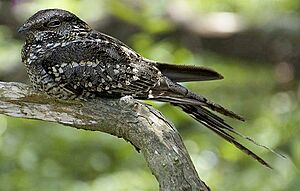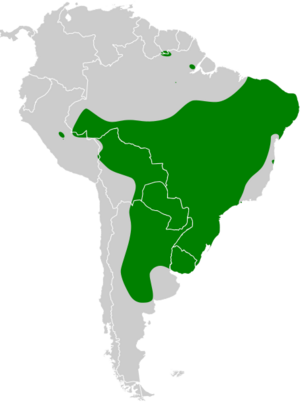Scissor-tailed nightjar facts for kids
Quick facts for kids Scissor-tailed nightjar |
|
|---|---|
 |
|
| Conservation status | |
| Scientific classification | |
| Genus: |
Hydropsalis
|
| Species: |
torquata
|
 |
|
| Synonyms | |
|
|
The scissor-tailed nightjar (scientific name: Hydropsalis torquata) is a cool bird that belongs to the nightjar family. It gets its name from the male's super long tail feathers, which look a bit like open scissors! You can find these birds living across much of eastern South America.
Contents
About the Scissor-Tailed Nightjar
The scissor-tailed nightjar was first officially described in 1789 by a German scientist named Johann Friedrich Gmelin. He gave it the scientific name Caprimulgus torquatus. Later, in 1832, another German scientist, Johann Georg Wagler, placed it in a new group called Hydropsalis. This group now includes three other similar birds.
The name Hydropsalis comes from ancient Greek words. Hudro- means "water," and psalis means "pair of scissors." The second part of its scientific name, torquata, is from Latin and means "collared," which refers to a band around its neck.
There are two main types, or subspecies, of the scissor-tailed nightjar:
- H. t. torquata: This type lives in southern Suriname, Brazil, and eastern Peru.
- H. t. furcifer: This type is found from southern Peru down to southern Brazil and central Argentina.
What Does It Look Like?
The most amazing thing about the male scissor-tailed nightjar is its super long outer tail feathers. These feathers can be almost twice as long as the rest of its body!
Without these long tail feathers, both male and female birds are about 25 to 30 centimeters (10 to 12 inches) long. But with the tail, a male can be up to 66 centimeters (26 inches) long! Males usually weigh between 47.5 and 63 grams (1.7 to 2.2 ounces), while females weigh 48 to 60 grams (1.7 to 2.1 ounces).
Males have brown feathers on their upper body with grayish-white spots. The middle of their back also has dark streaks and reddish-brown spots. They have a wide, reddish-brown collar around their neck. Their long tail feathers are brown with wide white tips.
The chin is light yellow-brown, and the throat is light yellow-brown or whitish with brown spots. The chest is light yellow-brown with thin brown stripes, and the belly and sides are light yellow-brown with wide brown stripes. Their wings are mostly brown with reddish-brown or light yellow-brown streaks and spots. Unlike many other nightjars, their wings don't have a white band.
Female scissor-tailed nightjars have more reddish-brown wings, and their tails don't have white tips. Their outer tail feathers are only a little bit longer than their inner ones. The H. t. furcifer type is generally bigger and paler than the other type, and its neck collar is more yellow-brown.
Sounds and Calls
The song of the scissor-tailed nightjar is a long series of "tsips" that can go on for minutes! They sing at dusk and dawn from a branch or while flying. They also make a very high "tsig" sound when flying and a low "clucking" sound.
Where Do They Live?
The H. t. torquata type of scissor-tailed nightjar lives from east-central Peru across central Brazil. There's also a small group of them living separately in Suriname. The H. t. furcifer type is found from southern Peru through Bolivia and across southern Brazil, all the way south to Paraguay, northern and central Argentina, and Uruguay.
These birds like to live in open or partly open areas. This includes places like:
- Areas where new plants are growing after old ones were cleared
- Dry, bushy areas
- Grasslands
- Groves of acacia trees
- Pastures
- City parks
You might even spot them along roads, especially next to sugar cane fields. They usually live from sea level up to about 1,100 meters (3,600 feet) high. But in Peru, they can be found as high as 1,700 meters (5,600 feet), and in Bolivia, up to 2,700 meters (8,900 feet)!
Birds in the northern parts of their range usually stay in the same place all year. However, the birds in the southern parts are thought to migrate. This means they fly to southern Amazonia during the winter months in the Southern Hemisphere.
Behavior and Life Cycle
What Do They Eat?
The scissor-tailed nightjar is a nocturnal bird, meaning it is active at night. It hunts for food by flying out from the ground or a perch to catch insects. Scientists have seen them eating insects from at least twelve different groups! They seem to really like beetles, and at least 13 different families of beetles have been found in their diet. During the day, they rest on the ground in shady spots.
Reproduction
Male scissor-tailed nightjars do a special "wing-clapping" dance to attract females. We don't know exactly when their nesting season is, but it seems to be from at least September to December. They lay two eggs directly on the ground or even on bare rock, without building a nest.
Conservation Status
The IUCN (International Union for Conservation of Nature) has listed the scissor-tailed nightjar as a species of "Least Concern." This means they are not currently in danger of disappearing. They live across a very large area, and even though we don't know their exact population size, it seems to be stable. These birds are quite common in most places they live and seem to be okay with human activity, even living in city parks!


